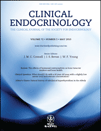Silent corticotroph adenomas have unique recurrence characteristics compared with other nonfunctioning pituitary adenomas
Summary
Objective The prevalence of silent corticotroph adenomas (SCAs) is not rare among nonfunctioning pituitary adenomas (NFPAs); however, it is unknown whether the clinical significance of SCAs differs from that of NFPAs without ACTH immunoreactivity (non-SCAs). Our goal was to compare the clinical characteristics and natural history between patients with SCAs and non-SCAs.
Design/patients We reviewed the medical records of all patients who underwent transsphenoidal surgery for NFPAs from January 1990 to October 2007 at the Seoul National University Hospital.
Measurements We analysed whether clinical manifestations at diagnosis, postoperative recurrence rate and recurrence characteristics differed between SCA and non-SCA patients.
Results In total, 28 patients with SCAs and 134 patients with non-SCAs were analysed. The mean age at the time of diagnosis was 44 years (range, 13–67 years) in the SCA group and 50 years (18–79 years) in the non-SCA group (P = 0·026), with respective follow-up periods of 5·2 (range, 1·0–16·0 years) and 4·2 years (0·5–16·1 years) (P = 0·255). Overall recurrence rates of SCAs and non-SCAs were 25·0% and 26·9% respectively (P = 0·839). More than two recurrences (P = 0·001) and recurrence after more than 5 years (P = 0·040) were associated with SCAs. Multiple recurrences of SCAs were confined to younger patients.
Conclusion The overall recurrence rate was similar between SCAs and non-SCAs. However, young patients with SCAs had a higher frequency of multiple and late recurrences, which showed more aggressive tumour behaviour. Therefore, we suggest that patients with SCAs, especially patients diagnosed at a young age, require careful long-term monitoring.




